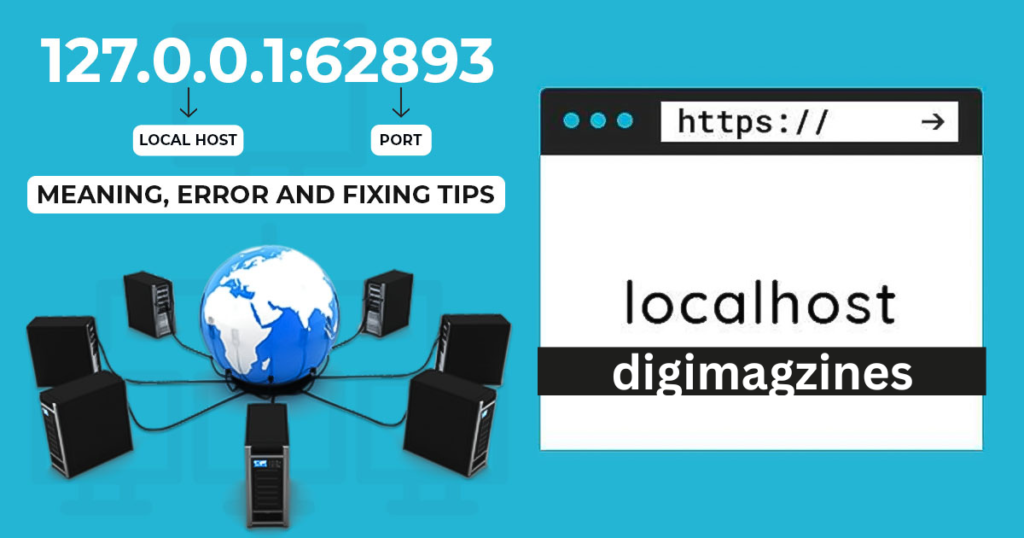Introduction to 127.0.0.1:62893 – The Localhost & Its Specific Port
In the world of networking, 127.0.0.1 is famously known as the localhost IP address. It’s a loopback address that points back to the user’s own system. Appended to this IP address, :62893 specifies a particular port number, making the full address 127.0.0.1:62893. This article delves into what this specific setup implies, its benefits, operational mechanisms, security considerations, and practical applications.
What Is 127.0.0.1:62893?
127.0.0.1 is your computer’s loopback address, used to establish an IP connection to the same machine using network protocols. The port number 62893 identifies a specific gateway through which programs communicate internally or prepare to engage with external servers. Understanding how and why to use this address and port combination can significantly enhance your troubleshooting and network testing capabilities.
Ultimate Benefits Of 127.0.0.1:62893
Using the loopback address with a designated port like 62893 offers several advantages:
- Testing and Development: Developers use this address to test network services without the risk of external network interference.
- Security: Since it is isolated from the external network, it provides a secure environment for running applications.
- Network Troubleshooting: It helps in diagnosing network issues and ensuring software can communicate over networks without external factors.
- Zero Network Traffic: This setup does not generate network traffic outside the host, making it efficient for performance testing.
How 127.0.0.1:62893 Works: Understanding Loopback and Localhost
At its core, the loopback mechanism allows a computer to communicate with itself. It is part of the Internet Protocol (IP) standard and is used primarily for testing and network configuration. Any data packets sent to 127.0.0.1 do not reach any external network; instead, they are routed back internally, allowing a device to talk to itself.
Is It Safe To Expose Port 62893 Publicly?
Exposing any port, including 62893, can open up your system to potential vulnerabilities if not securely managed. Generally, ports associated with 127.0.0.1 should not be exposed outside of the local system because they are meant for internal communications. If external access is necessary, proper security measures, including firewalls and authentication protocols, must be implemented.
How Do You Have the IP Address of Your Computer?
Retrieving your computer’s IP address is straightforward:
- Windows: Open Command Prompt and type
ipconfig. - Mac/Linux: Start Final and type ifconfig or ip a.
These commands provide detailed network configuration details, including the IP address.
Top Fixing Tips for Common Issues with Localhost Connections
Troubleshooting localhost issues can be crucial for maintaining seamless development and testing processes:
- Ensure Services are Running: Check that the services meant to listen on
127.0.0.1:62893are up and running. - Firewall Settings: Adjust your firewall settings to allow traffic on port 62893 if it’s being blocked.
- Port Availability: Ensure no other service is using the same port. If the port is already in use, consider using a different one.
Applications in Real-World Scenarios
The localhost address is crucial in various scenarios, from software development and API testing to network configuration and security assessments. It allows developers and IT professionals to simulate server environments on a local machine, test applications securely, and configure server behaviors.
Still Facing Issues? Prime Repairing Strategies for Popular Problems with 127.0.0.1:62893
When working with the localhost IP address 127.0.0.1 and specifically targeting port 62893, you might encounter various issues that can hinder your development or testing processes. Here’s a practical guide to troubleshooting common problems and ensuring your configurations run smoothly.
1. Check Service Status
- What to Do: Ensure that the application or service meant to run on
127.0.0.1:62893is active. Use tools likenetstatorlsofto check if the port is listening. - Commands:
- On Windows:
netstat -aon | findstr :62893 - On Linux/Mac:
lsof -i :62893ornetstat -anp | grep 62893
- On Windows:
2. Firewall Configuration
- What to Do: Verify if your firewall is blocking connections to or from port
62893. Adjust the firewall settings to allow these connections if necessary. - Guidance: Add rules to allow inbound and outbound traffic on port
62893.
3. Port Availability
- What to Do: Sometimes, port
62893may already be in use by another process, which can prevent your intended service from binding to it. - Solution: Find the process using the port and terminate it if it’s not needed or choose an alternate port for your service.
4. Configuration Errors
- What to Do: Check configuration files for any incorrect settings such as wrong port numbers, IP addresses, or protocol details.
- Tip: Always validate configurations against documentation to ensure accuracy.
5. Network Interface Issues
- What to Do: Ensure that your network interface is configured correctly and capable of handling loopback traffic.
- Check: Use
ipconfig(Windows) orifconfig(Linux/Mac) to verify network settings.
6. Software Specific Debugging
- What to Do: Consult the logs for your specific application. Most server software and development tools provide detailed logs that can clue you in on what might be going wrong.
- Procedure: Access application logs typically found in the service’s home directory or configured log output paths.
7. Resource Constraints
- What to Do: Lack of system resources like CPU or memory can cause services running on
127.0.0.1:62893to fail. - Monitor: Use system monitoring tools like Task Manager, Activity Monitor, or top/htop to watch for high resource usage.
8. Use of Virtualization Tools
- What to Do: If you’re running services inside virtual machines or containers, network settings can get tricky. Ensure that port forwarding and network bridging are correctly set up.
- Advice: Double-check your VM or container network configurations and ensure they align with host settings.
Conclusion: Maximizing the Utility of 127.0.0.1:62893
Understanding the functionality and advantages of using 127.0.0.1:62893 is vital for anyone involved in network management, software development, or system administration. By harnessing the power of the localhost and managing port usage wisely, you can significantly enhance your operational efficiency and security posture.


